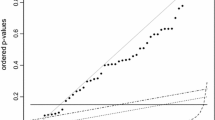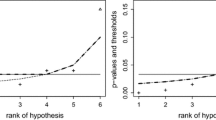Abstract
Traditional multiple hypotheses testing mainly focuses on constructing stepwise procedures under some error rate control, such as familywise error rate (FWER), false discovery rate, and so forth. However, most of these procedures are obtained in independent case, and when there exists correlation across tests, the dependency may increase or decrease the chance of false rejections. In this paper, a totally different testing method is proposed, which doesn’t focus on specific error control, but pays attention to the overall performance of the collection of hypotheses and the structure utilization among hypotheses. Since the main purpose of multiple testing is to pick out the false ones from the whole hypotheses and present a rejection set, motivated by the principle of simple hypothesis testing, we give the final testing result based on the estimation of the set of all the true null hypotheses. Our method can be applied in any dependent case provided that a reasonable \(p\)-value can be obtained for each intersection hypothesis. We illustrate the new procedures with application to multiple comparisons problems. Theoretical results show the consistency of our method, and investigate their FWER behavior. Simulation results suggest that our procedures have a better overall performance than some existing procedures in dependent cases, especially in the total number of type I and type II errors.
Similar content being viewed by others
References
Benjamini Y, Hochberg Y (1995) Controlling the false discovery rate: a practical and powerful approach to multiple testing. J R Stat Soc B 57:289–300
Benjamini Y, Krieger AM, Yekutieli D (2006) Adaptive linear step-up procedures that control the false discovery rate. Biometrika 93:491–507
Benjamini Y, Yekutieli D (2001) The control of the false discovery rate in multiple testing under dependency. Ann Stat 29:1165–1188
Bernhard G, Klein M, Hommel G (2004) Global and multiple test procedures using ordered \(p\)-values—a review. Stat Pap 45:1–14
Cohen A, Sackrowitz HB, Xu M (2009) A new multiple testing method in the dependent case. Ann Stat 37:1518–1544
Dawid AP, Stone M (1982) The functional-model basis of fiducial inference. Ann Stat 10:1054–1067
Dudoit S, Van Der Laan M (2008) Multiple Testing Procedures with Applications to Genomics. Springer, New York
Efron B, Tibshirani R, Storey J, Tusher V (2001) Empirical Bayes analysis of a microarray experiment. J Am Stat Assoc 96:1151–1160
Fan J, Han X, Gu W (2012) Estimating false discovery proportion under arbitrary covariance dependence. J Am Stat Assoc 107:1019–1035
Hochberg Y, Tamhane AC (1987) Multiple comparison procedures. Wiley, New York
Holm S (1979) A simple sequentially rejective multiple test procedure. Scand J Stat 6:65–70
Hsu JC (1996) Multiple comparisons: theory and methods. Chapman & Hall, London
Lehmann EL, Romano JP (2005) Generalizations of the familywise error rate. Ann Stat 33:1138–1154
Li X, Xu X, Li G (2007) A fiducial argument for generalized \(p\)-value. Sci China Ser A Math 50:957–966
Miller RG (1966) Simultaneous statistical inference. McGraw-Hill, New York
Pigeot I (2000) Basic concepts of multiple tests—a survey. Stat Pap 41:3–36
Romano JP, Shaikh AM, Wolf M (2008) Control of the false discovery rate under dependence using the bootstrap and subsampling. Test 17:417–442
Romano JP, Wolf M (2007) Control of generalized error rates in multiple testing. Ann Stat 35:1378–1408
Sarkar SK (2008) Two-stage stepup procedures controlling FDR. J Stat Plann Inference 138:1072–1084
Storey JD (2003) The positive false discovery rate: a Bayesian interpretation and the \(q\)-value. Ann Stat 31:2013–2035
Tsui KW, Weerahandi S (1989) Generalized \(p\)-values in significance testing of hypotheses in the presence of nuisance parameters. J Am Stat Assoc 84:602–607
Tukey JW (1953) The problem of multiple comparisons. In: The collected works of John H. Tukey VIII. Multiple comparisons: 1948–1983. Chapman & Hall, New York, pages 1–300
Westfall PH, Young SS (1993) Resampling-based multiple testing: examples and methods for \(p\)-value adjustment. Wiley, New York
Yin Y (2012) A new Bayesian procedure for testing point null hypotheses. Comput Stat 27:237–249
Acknowledgments
The authors would like to thank the the editor and the referee for their useful comments, which led to a considerable improvement of the paper. This work was supported by the National Natural Science Foundation of China (Grant No.11471030, 11471035).
Author information
Authors and Affiliations
Corresponding author
Appendix
Appendix
Proof of Lemma 1
(i) Since for \(J \subseteq I_0\), \(p(J)\sim U(0,1)\), the result is obtained immediately.
(ii) \(\forall J\nsubseteq I_0\),
case 1. \(\sigma ^2\) is known
Denote
where \(R\) is positive definite. Then
Notice that
then \(Y_{1n}=O_p(1)\), \(Y_{2n}=O_p(\sqrt{n})\). Additionally, \(Y_{3n}\asymp n\), so \(Y_n\asymp _p n\), that is to say, \(Y_n\) is of the same order as \(n\) in probability.
Since \(\chi ^{-2}_m(1-\alpha (n))=o(n)\), \(\chi ^{-2}_{r_J}(1-\alpha (n))=o(n)\). So
case 2. \(\sigma ^2\) is unknown
Similarly as before, let
Since \(S^2\) converges to \(\sigma ^2\) in probability, the remaining is as similar as that of case 1. \(\square \)
Proof of Lemma 2
For any \(\alpha \) satisfying (C0), from Lemma 1, we have
\(\square \)
Proof of Theorem 1
(i) For All-sets-down procedure,
then
(ii) For All-sets-up procedure,
Since
and \( \lim \limits _{n\rightarrow \infty }\mathrm{Pr}(p(I_0)\le \alpha )=0\), we immediately get
(iii) For Nested-up procedure, let
From Lemma 1 and Lemma 2, we have \(\lim \limits _{n\rightarrow \infty }\mathrm{Pr}(D_n)=1\). Therefore, as long as there exists at least one true null hypothesis in that step, a true null will be accepted in probability. Since
and \(\lim \limits _{n\rightarrow \infty }\mathrm{Pr}(p(J)\le \alpha )=1,J\supset I_0\), we have
\(\square \)
Proof of Proposition 1
When all the null hypotheses are true, for All-sets-down and Nested-down procedures,
\(\square \)
Proof of Proposition 2
Without loss of generality, suppose there exists at least one false null hypotheses. Denote \(V_n\) be the number of false rejections, so \(\mathrm{FWER}=\mathrm{Pr}(V_n\ge 1)\). For All-sets-down procedure,
where
Since \(H_K\) is false, with \(|K|>|I_0|\), for any fixed \(\alpha \), \(\alpha \in (0,1)\),
Additionally, from Lemma 2,
so \(\lim _{n\rightarrow \infty }\mathrm{Pr}(F_n)=0.\)
Furthermore, since \(\mathrm{Pr}\left( p(I_0)\le \alpha \right) =\alpha \), and
we get \(\lim _{n\rightarrow \infty }\mathrm{Pr}(G_n)=\alpha .\)
It’s easy to see
Since
we have
\(\square \)
Rights and permissions
About this article
Cite this article
Wang, L., Xu, X. & A, Y. New multiple testing method under no dependency assumption, with application to multiple comparisons problem. Stat Papers 57, 161–183 (2016). https://doi.org/10.1007/s00362-014-0650-2
Received:
Revised:
Published:
Issue Date:
DOI: https://doi.org/10.1007/s00362-014-0650-2




